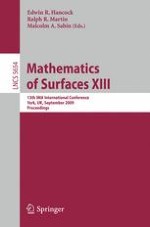This book constitutes the refereed proceedings of the 13th IMA International Conference on the Mathematics of Surfaces held in York, UK in September 2009. The papers in the present volume include seven invited papers, as well as 16 submitted papers. The topics covered include subdivision schemes and their continuity, polar patchworks, compressive algorithms for PDEs, surface invariant functions, swept volume parameterization, Willmore flow, computational conformal geometry, heat kernel embeddings, and self-organizing maps on manifolds, mesh and manifold construction, editing, flattening, morphing and interrogation, dissection of planar shapes, symmetry processing, morphable models, computation of isophotes, point membership classification and vertex blends. Surface types considered encompass polygon meshes as well as parametric and implicit surfaces.
